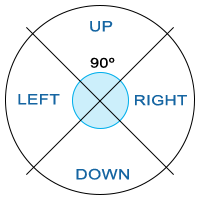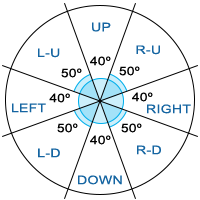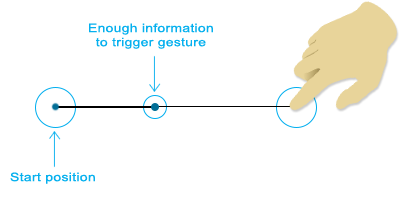Simple Gesture is a Unity plugin that allows developers to easily detect gestures for touch-screen devices in just one line of code. It can be easely integrated in any project, as it works with both C# and UnityScript.
First of all, you will have to download the package from the AssetsStore. Once you have dowloaded and imported the assets you will need to configure... no, wait. That's all! :-D
If you open the SimpleGesture main folder you will see a bunch of folders that contain other folders, with scripts and more scripts. For the moment, just forget about it. All you need to know is that there's a class called SimpleGesture, and this is everything you'll need.
But let's see how this works. Create a new script and attach it to a Game Object. Inside the script, look for the Awake method and add the following line of code. This line of code will tell the SimpleGesture framework that, everytime a tap gesture is detected, call the custom method named MyMethod.
public void Awake()
{
SimpleGesture.OnTap(MyMethod);
}All we need to do now is to print a message to check if it works. When testing this, instead of building the app and installing it in an Android or an iOS device, I would recomment using the Unity Remote app. It's available for free for both operating systems and it's much faster that waiting to finish the compile/compress/install/execute processes.
public void MyMethod()
{
Debug.log("Yay! I just tapped!");
}IMPORTANT NOTE! Don't add the Simple Gesture script to any component. This plugin is smart enough to know if other scene scripts are using it. If so, an instance of the plugin's base class is created automatically.
Simple Gesture has many methods to detect a wide variety of gestures. But there's a common naming convention between all of them.
- Discrete gestures: discrete methods are methods that happen once the user has lifted the finger, such as taps, circles, zig-zags, etc. All this methods begin with the On prefix: (
OnTap,OnSwipe, ...). - Continuous gestures: These methods deal with gestures that continuously happen while the user moves the finger around the screen. These methods begin with the While prefix and a gerund as the gesture verb: (
WhilePanning,WhileTwisting, ...). - Stop detection: Sometimes you will want to stop detecting certain gestures. These methods begin with the Stop prefix and replace the On or While prefix: (
StopTap,StopPanning, ...).
All these methods are described in detail below.
Tap Gestures are triggered when the user touches the screen and lifts the finger without barely moving.
OnTap detects when a finger clicks the screen, without taking into acount the time the finger stays on the screen.
SimpleGesture.OnTap(MyCallback);###OnShortTap
OnShortTap detects when a finger clicks the screen, but the time between the first touch and the release of the finger is less than 0.5 seconds.
SimpleGesture.OnShortTap(MyCallback);###OnLongTap
OnShortTap detects when a finger clicks the screen, but the time between the first touch and the release of the finger is greater than 0.5 seconds.
SimpleGesture.OnLongTap(MyCallback);OnDoubleTap detects when a finger clicks the screen a second time within a short time span (half a second by default).
SimpleGesture.OnDoubleTap(MyCallback);If you want to know more information about this gesture, simply add a GestureInfoTap parameter type at your custom function, and SimpleGesture will provide more information about the gesture detected. In particular, GestureInfoTap provides:
public class GestureInfoTap {
public Vector2 position;
public float duration;
}
- [Vector2] position: The position of the touch in screen-space.
- [float] duration: The duration of the tap (in seconds).
Example:
public void Awake() {
SimpleGesture.OnTap(MyTapCallback);
}
public void MyTapCallback(GestureInfoTap gesture) {
Debug.Log("Tap!");
Debug.Log("Position:" + gesture.position);
Debug.Log("Duration:" + gesture.duration);
}Swipe Gestures are triggered after drawing a straight line with one finger.
OnSwipe is triggered when a finger swipes in any direction around the screen and after the finger is lifted.
SimpleGesture.OnSwipe(MyCallback);4 axis swipes are methods that detect swipes in only 4 directions (up, right, down and left). To decide the direction of the swipe, the space is divided in 4 quadrants, each with an angle of 90º.
On4AxisSwipeUp is triggered when a finger swipes up around the screen and after the finger is lifted.
SimpleGesture.On4AxisSwipeUp(MyCallback);
On4AxisSwipeDown is triggered when a finger swipes up around the screen and after the finger is lifted.
SimpleGesture.On4AxisSwipeDown(MyCallback);
On4AxisSwipeRight is triggered when a finger swipes up around the screen and after the finger is lifted.
SimpleGesture.On4AxisSwipeRight(MyCallback);
On4AxisSwipeLeft is triggered when a finger swipes up around the screen and after the finger is lifted.
SimpleGesture.On4AxisSwipeLeft(MyCallback);
9 axis swipes are methods that detect swipes in 8 directions (up, right, down and left and their diagonals). To decide the direction of the swipe, the space is divided in 8 quadrants, each with an angle of 40º and 50º (this last corresponding to the diagonal quadrants).
On9AxisSwipeUp is triggered when a finger swipes up around the screen and after the finger is lifted.
SimpleGesture.On9AxisSwipeUp(MyCallback);
On9AxisSwipeDown is triggered when a finger swipes up around the screen and after the finger is lifted.
SimpleGesture.On9AxisSwipeDown(MyCallback);
On9AxisSwipeRight is triggered when a finger swipes up around the screen and after the finger is lifted.
SimpleGesture.On9AxisSwipeRight(MyCallback);
On9AxisSwipeLeft is triggered when a finger swipes up around the screen and after the finger is lifted.
SimpleGesture.On9AxisSwipeLeft(MyCallback);
On9AxisSwipeDiagonalRightUp is triggered when a finger swipes up around the screen and after the finger is lifted.
SimpleGesture.On9AxisSwipeDiagonalRightUp(MyCallback);
On9AxisSwipeDiagonalRightDown is triggered when a finger swipes up around the screen and after the finger is lifted.
SimpleGesture.On9AxisSwipeDiagonalRightDown(MyCallback);
On9AxisSwipeDiagonalLeftUp is triggered when a finger swipes up around the screen and after the finger is lifted.
SimpleGesture.On9AxisSwipeDiagonalLeftUp(MyCallback);
On9AxisSwipeDiagonalLeftDown is triggered when a finger swipes up around the screen and after the finger is lifted.
SimpleGesture.On9AxisSwipeDiagonalLeftDown(MyCallback);
Flick Swipes act like the other swipe methods, but they don't wait for the finger to be lifted. Instead, as soon as the gesture is recognized as a swipe, the flick swipes are triggered.
On4AxisFlickSwipeUp is triggered when a finger swipes up around the screen and as soon as there is enough information to know the gesture is a swipe.
SimpleGesture.On4AxisFlickSwipeUp(MyCallback);
On4AxisFlickSwipeDown is triggered when a finger swipes up around the screen and as soon as there is enough information to know the gesture is a swipe.
SimpleGesture.On4AxisFlickSwipeDown(MyCallback);
On4AxisFlickSwipeRight is triggered when a finger swipes up around the screen and as soon as there is enough information to know the gesture is a swipe.
SimpleGesture.On4AxisFlickSwipeRight(MyCallback);
On4AxisFlickSwipeLeft is triggered when a finger swipes up around the screen and as soon as there is enough information to know the gesture is a swipe.
SimpleGesture.On4AxisFlickSwipeLeft(MyCallback);
On9AxisFlickSwipeUp is triggered when a finger swipes up around the screen and as soon as there is enough information to know the gesture is a swipe.
SimpleGesture.On9AxisFlickSwipeUp(MyCallback);
On9AxisFlickSwipeDown is triggered when a finger swipes up around the screen and as soon as there is enough information to know the gesture is a swipe.
SimpleGesture.On9AxisFlickSwipeDown(MyCallback);
On9AxisFlickSwipeRight is triggered when a finger swipes up around the screen and as soon as there is enough information to know the gesture is a swipe.
SimpleGesture.On9AxisFlickSwipeRight(MyCallback);
On9AxisFlickSwipeLeft is triggered when a finger swipes up around the screen and as soon as there is enough information to know the gesture is a swipe.
SimpleGesture.On9AxisFlickSwipeLeft(MyCallback);
On9AxisFlickSwipeRightUp is triggered when a finger swipes up around the screen and as soon as there is enough information to know the gesture is a swipe.
SimpleGesture.On9AxisFlickSwipeRightUp(MyCallback);
On9AxisFlickSwipeRightDown is triggered when a finger swipes up around the screen and as soon as there is enough information to know the gesture is a swipe.
SimpleGesture.On9AxisFlickSwipeRightDown(MyCallback);
On9AxisFlickSwipeLeftUp is triggered when a finger swipes up around the screen and as soon as there is enough information to know the gesture is a swipe.
SimpleGesture.On9AxisFlickSwipeLeftUp(MyCallback);
On9AxisFlickSwipeLeftDown is triggered when a finger swipes up around the screen and as soon as there is enough information to know the gesture is a swipe.
SimpleGesture.On9AxisFlickSwipeLeftDown(MyCallback);
If you want to know more information about this gesture, simply add a GestureInfoSwipe parameter type at your custom function, and SimpleGesture will provide more information about the gesture detected. In particular, GestureInfoSwipe provides:
public class GestureInfoSwipe {
public Vector2 direction;
public float distance;
public Vector2 firstPosition;
public Vector2 endPosition;
}
- [Vector2] direction: The average normalized direction of the swipe in screen-space.
- [float] distance: The distance of the swipe.
- [Vector2] firstPosition: The position of this gesture's first touch.
- [Vector2] lastPosition: The position of this gesture's last touch.
Example:
public void Awake() {
SimpleGesture.On4AxisSwipeLeft(MySwipeLeftCallback);
}
public void MySwipeLeftCallback(GestureInfoSwipe gesture) {
Debug.Log("Left Swipe!");
Debug.Log("Direction:" + gesture.direction);
Debug.Log("distance:" + gesture.distance);
}
Shape Gestures are triggered when SimpleGesture detects a certain shape drawn with the finger.
OnCircle detects when a finger draws a circle on the touch-screen.
SimpleGesture.OnCircle(MyCallback);###OnZigZag
OnZigZag detects when a finger draws a zig-zag on the touch-screen of at least 3 edges.
SimpleGesture.OnZigZag(MyCallback);If you want to know more information about this gesture, simply add a GestureInfoCircle/GestureInfoZigZag parameter type at your custom function, and SimpleGesture will provide more information about the gesture detected. In particular, GestureInfoCircle provides:
public class GestureInfoCircle {
public Vector2 center;
public float radius;
}
- [Vector2] center: The average center of the circle drawn in screen-space.
- [float] radius: The average radius of the circle drawn in screen-space.
Example:
public void Awake() {
SimpleGesture.OnCircle(MyCircleCallback);
}
public void MyCircleCallback(GestureInfoCircle gesture) {
Debug.Log("Circle!");
Debug.Log("Center:" + gesture.center);
Debug.Log("Radius:" + gesture.radius);
}And GestureInfoZigZag provides:
public class GestureInfoZigZag {
public Vector2 direction;
public float distance;
}
- [Vector2] direction: The average direction of the zig-zag drawn.
- [float] distance: The distance of the zig-zag.
Example:
public void Awake() {
SimpleGesture.OnZigZag(MyZigZagCallback);
}
public void MyZigZagCallback(GestureInfoZigZag gesture) {
Debug.Log("ZigZag!");
Debug.Log("Direction:" + gesture.direction);
Debug.Log("Distance:" + gesture.distance);
}Continuous Gestures are triggered constantly as long as the finger/s is/are moving. For example, panning is a continuous gesture, because it is triggered while the finger is moving, and not when the finger is lifted (it wouldn't make any sense).
While1FingerPanning detects when a finger moves around the screen.
SimpleGesture.While1FingerPanning(MyCallback);###WhilePanning
WhilePanning detects when 2 or more fingers move together around the screen.
SimpleGesture.WhilePanning(MyCallback);###WhilePinching
WhilePinching detects when 2 fingers pinch the screen (zoom out).
SimpleGesture.WhilePinching(MyCallback);###WhileStretching
WhileStretching detects when 2 fingers stretch the screen (zoom in).
SimpleGesture.WhileStretching(MyCallback);###WhileTwisting
WhileTwisting detects when 2 fingers rotate around a pivot.
SimpleGesture.WhileTwisting(MyCallback);If you want to know more information about this gesture, simply add a GestureInfoPan / GestureInfoZoom / GestureInfoTwist parameter type at your custom function, and SimpleGesture will provide more information about the gesture detected.
In particular, GestureInfoPan, from While1FingerPanning and WhilePanning provides:
public class GestureInfoPan {
public Vector2 deltaDirection;
}
- [Vector2] deltaDirection: The direction (and amount of movement) of the panning since the last event fired. No need to multiply by Time.deltaTime, as it's already frame-based.
Example:
public void Awake() {
SimpleGesture.WhilePanning(MyPanCallback);
}
public void MyPanCallback(GestureInfoPan gesture) {
Debug.Log("Panning!");
Debug.Log("movement:" + gesture.deltaDirection);
}On the other hand, WhilePinching and WhileStretching provide the following class info:
public class GestureInfoZoom {
public float deltaDistance;
public Vector2 center;
public Vector2 position1;
public Vector2 position2;
}
- [float] deltaDistace: The amount of distance movemtn since the last zoom event. No need to multiply by Time.deltaTime, as it's already frame-based.
- [Vector2] center: The pivot where the zoom focuses.
- [Vector2] position1: The position of finger 1.
- [Vector2] position2: The position of finger 2.
Example:
public void Awake() {
SimpleGesture.WhilePinching(MyZoomCallback);
}
public void MyZoomCallback(GestureInfoZoom gesture) {
Debug.Log("Pinching!");
Debug.Log("Center:" + gesture.center);
}And for the WhileTwisting detector, the information retrieved is:
public class GestureInfoTwist {
public float deltaDistance;
public Vector2 center;
public Vector2 position1;
public Vector2 position2;
public bool clockwise;
}
- [float] deltaDistace: The amount of distance movemtn since the last zoom event. No need to multiply by Time.deltaTime, as it's already frame-based.
- [Vector2] center: The pivot where the zoom focuses.
- [Vector2] position1: The position of finger 1.
- [Vector2] position2: The position of finger 2.
- [bool] clockwise: Whether the twisiting is clockwise (true) or counter-clockwise (false).
Example:
public void Awake() {
SimpleGesture.WhileTwisting(MyTwistCallback);
}
public void MyTwistCallback(GestureInfoTwist gesture) {
Debug.Log("Twisting!");
Debug.Log("Center:" + gesture.center);
Debug.Log("Is Clockwise?:" + gesture.clockwise);
}

